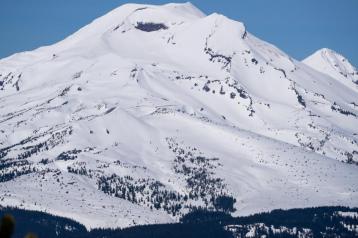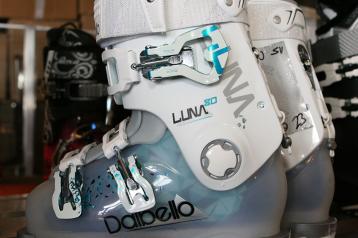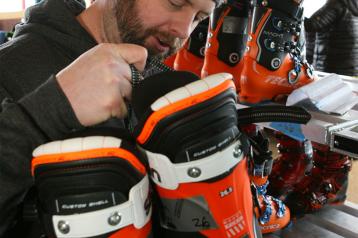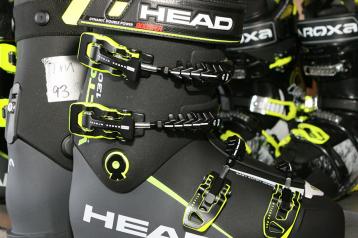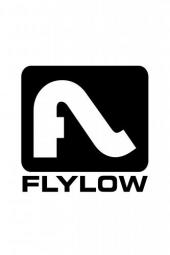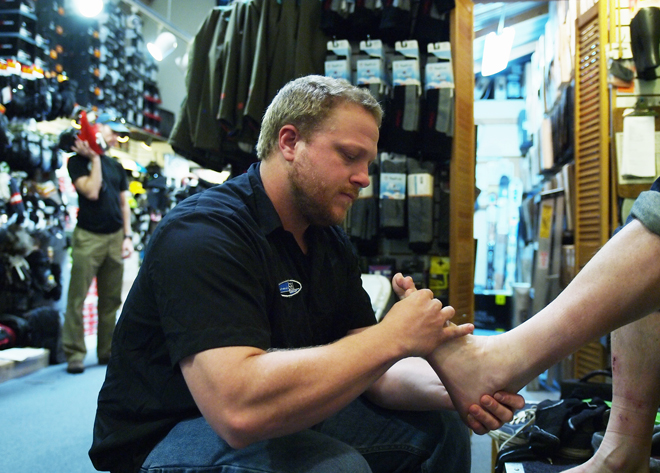
10 Steps to a Perfect Bootfit
1.DON’T LISTEN TO YOUR FRIENDS
Boots not only have to match your skill level, they must mate with your foot and leg shape. That means your pal’s star may be your black hole of pain. Since on-slope boot testing opportunities are rare, visit an America’s Best Boot Fitters shop where our experienced techs can analyze your feet and help you narrow down the choices.
2. TAKE YOUR TIME—LOT’S OF IT
Buying ski boots is a time-consuming process that too many skiers rush through. You probably spent an hour selecting your last pair of running shoes —and they’re made from pliable materials! A plastic boot shell will not mold to your foot’s subtle nuances, even if you wear it all day, every day, for 25 years so take your time to make the right choice. Expect the process to take hours, not minutes. Even with an ABB tech’s guidance, you should plan to try on a variety of different brands, models and sizes.
When you seem to have mined a gem, leave it on your feet and walk around the shop for 10 or 15 minutes. Flex repeatedly to seat the foot and start the foams compressing.
3. MAKE IT A ROUND-ROBIN ELIMINATION TOURNAMENT
Try different models and different sizes of the same model on your left and right feet. Keep the “winner” on and pit it against newcomers. Remember, though, your feet are probably not identical and may vary in size so when you find “winners,” try on both boots.
4. SHOP WHEN NOBODY’S AROUND
For the best boot fit service, visit ABB city and suburban shops midweek in early fall at off-hours. During ski season, ABB resort shops are busiest early in the morning and right around lift closing. Trade sliding time for personal attention and go when everyone else is out skiing. And remember, your feet can swell up to a half-size during skiing so size to fit them at their largest. For the best fit, shop in the afternoon or evening or after physical activity.
5. TOO BIG IS A BIG PROBLEM
Many people buy their boots too big. Understandably so. A good fitting boot feels tight out of the box and may remain very snug during the first few days of skiing. Relax. Your liner will pack out and become roomier with use. We’ve tested hundreds of brand new boots over the years and most initially feel short and tight but compress to comfortable levels after being skied as few as two runs. Frequently our testers batten down all the buckles an additional notch after just one run.
It’s common, though, for there to be some snugness for the first few days you ski a new boot. Buying a boot that’s too big can be painful and cause injuries. In extreme cases, oversized boots can cause ankle sprains and bone breaks. Oversized boots also hinder skiing and promote fatigue. You’ll find yourself in the “backseat,” clawing your toes and tightening your thigh muscles and hamstrings to maintain stability and control.
6. SHELL FIT IS PARAMOUNT
ABB tech’s can easily shim, trim or stretch boots but shell work is best kept to a minimum. To check shell fit, remove the liner and put your foot in the shell. Slide your foot forward until your big toe touches the front. A finger to a finger-and-a-half of space between your heel and the shell will give you a good snug fit when the liner is reinserted, assuming no other parts of your foot are touching the shell. If you feel contact, these are potential “hot spots” and your boot fitter may suggest another model or customization options.
7. BEWARE OF SHORTLASTED LINERS
If a boot has a good shell fit but feels unusually tight with the liner reinserted, have your boot tech check for a “short lasted” liner. Manufacturers spec a small gap between the toe of the liner and the shell to ensure liner toe boxes don’t become crumpled when they’re inserted into the shell at the factory. Sometimes, though, liners come from the factory as much as a half-inch shorter than the shell cavity. Your ABB tech can stretch them.
8. THE CUFF IS IMPORTANT STUFF
Boots have high cuffs for other reasons than to keep the snow out; studies show the cuff is critical for controlling your skis. You’ll ski with greater stability and confidence in a boot that contours snugly along your lower leg. The cuff should wrap snugly with your buckle bails set somewhere near the beginning to middle of the ladders. (Remember, the liner materials will compress!) If you’re near the end of the ladder, the buckles may deform the shell and change the boot’s intended flex pattern. Remember to use the macro and micro adjustments common to most buckles to custom tailor your fit.
Just as important as leg contact is the angle of the cuff in relation to your skeletal structure. If the cuff angle doesn’t follow your lower leg, your skis will not sit flat on the snow and you will have problems controlling your skis. For the approximately 75 percent of the skier population with bowleg or knock-kneed tendencies, it is nearly impossible to create a balanced stance in boots without a cuff cant adjuster. If you fit into either category, make sure your boot cuff has one.
Cuff height also dramatically affects stance. Short skiers particularly may have difficulty balancing in boots with tall cuffs. Bowleg or knock-knee skiers may experience similar problems. If you’re having stance problems in a tall cuff boot, try models with lower cuffs. ABB Certified boot techs will be able to spot balance problems and help you select proper models.
9. BEWARE OF MARKED SIZES
Use the manufacturer’s marked size only as a guideline. The sole length and inner cavities of supposedly similarly sized models can vary significantly. We’ve seen boots marked 27.5 vary from 305mm to 314mm. It’s easy to check the sole length; it’s embossed into the outside heel sidewall of nearly every boot. Liner construction and materials also affect fit. It’s not uncommon for a manufacturer’s Race model liner to feel too tight while the Freeride model in the same collection will feel just right because of the softer foams that are usually employed.
10. VISIT AN ABB SHOP
Don’t negotiate the minefield of boot selection with a novice. It is the most complex piece of sports gear you’ll probably ever purchase. Buying at a shop that displays the ABB logo is your assurance that that your boot tech has received the best training and expertise available to help you make the right choice.
